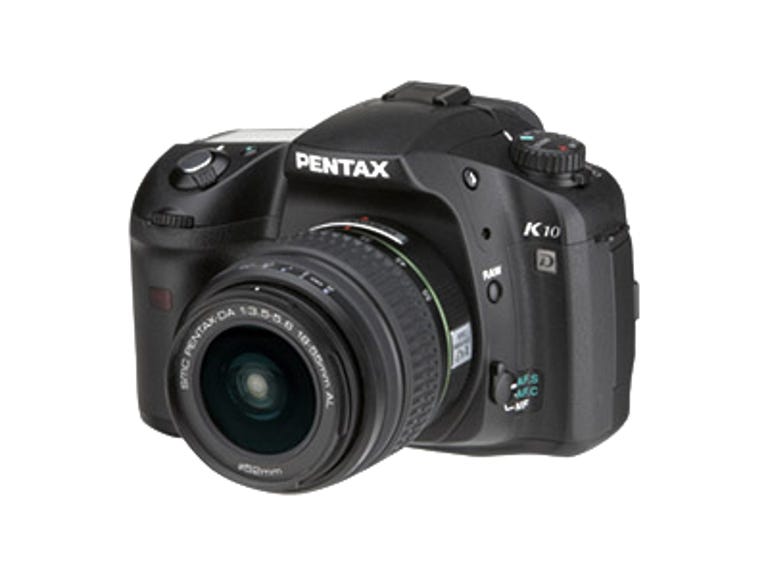 Why You Can Trust CNET
Why You Can Trust CNET Pentax K10D review: Pentax K10D
A great feature set for the price, pro-level customization, and excellent photo quality make the Pentax K10D a bargain amateur dSLR. Only unremarkable performance holds it back from joining the pack leaders.
If you're looking to start afresh with a dSLR system but don't have a lot of cash to plunk down, the Pentax K10D may be your budget's dream come true. True, there are a lot of sub-$1,000 dSLRs out there today, but the K10D offers features that you don't normally see in this price range: a 10-megapixel CCD with integrated lens-shift Shake Reduction technology; a solidly built dust- and weather-resistant body; a full set of exposure modes, including Bulb and external sync; interchangeable focusing screens; and an 11-point selectable autofocus.
The Good
The Bad
The Bottom Line
As part of a system, the K10D remains reasonably cost effective, as well. Pentax offers an inexpensive, nicely designed battery grip and a decent, not-too-painfully priced array of amateur and pro KAF2-mount lenses and flashes. At 1.8 pounds, the K10D's body feels substantial, and every door, button, dial, and switch feels high quality, another rarity for its price class. It may be the same fundamental camera as the Samsung GX-10, but small differences in design make me prefer the Pentax to its Samsung fraternal twin. (Check out this side-by-side comparison of the two.)
Though aggressively priced, don't mistake the K10D for baby's first dSLR, unless baby's last camera was a midrange film model. Unlike similarly priced entry-level models, the K10D lacks the step-up automation, such as scene modes and verbose help, that assists newbies making the snapshot-to-SLR transition. In fact, a beginner confronted with the six pages of custom setting options--including a dizzying number of configuration combinations for the front and back dials--might run screaming for the nearest Kodak.
There's not so much a learning curve with the K10D as there is a comfort curve. If you've shot with a dSLR, it's immediately obvious what the controls do, but getting into the rhythm of using them quickly and fluidly may take a bit of time. For instance, Pentax uses a very point-and-shoot-like Fn menu to adjust ISO speed, white balance, flash mode, and drive mode; it's easy to know and use, but hard to break the habit of looking for an on-body control while shooting. (For a detailed listing of the K10D's features, I suggest you download and scan through the PDF version of the manual.)
I was also quite impressed with the K10D's photo quality as well, from its broad dynamic range to first-rate color reproduction. Photos had an excellent noise profile up through ISO 800, and at its maximum of ISO 1600 still fared well for its price class.
On the other hand, though the K10D performs well for its class, it doesn't really stand out. Its time to first shot and typical shutter lag of about half a second come in around the average, and difficulty autofocusing in dim light results in a 1.6 second lag in suboptimal environments. At half a second, JPEG and raw shot-to-shot speeds also fall in the middle of the pack, though its 3.1fps continuous-shooting clip elevates it a bit above the budget crowd. Occasionally I ran into focus lock issues--usually during close-ups--where it would rock back and forth quickly for a few iterations, as if trying to decide whether or not it was satisfied. Most of the time I fell into a rhythm with it, as you do with any good camera, but occasionally missed a shot waiting for it to catch up.
As with most LCDs, the color and exposure reproduction on the K10D's 2.5-inch screen can't be trusted; it's so contrasty, in fact, that I couldn't really judge whether the flash was operating the way I wanted. You just have to close your eyes and trust the histograms.
If you're looking for a first dSLR or a no-brainer kit, the Pentax K10D may be too much for you, as in too much power and too expensive. But if you want to buy into an inexpensive system with a really good amateur dSLR at its hub, the K10D hits the mark.
(Shorter bars indicate better performance)
| Shutter lag (dim light) | Time to first shot | Shutter lag (typical) |
(Longer bars indicate better performance)
| In frames per second |
(Shorter bars indicate better performance)
| Raw shot-to-shot time | Typical shot-to-shot time |



